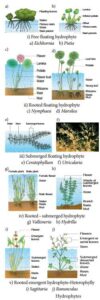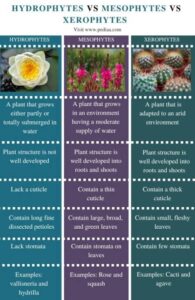Back to: Botany 200 Level
Hello, my brilliant student! How are you today? Have you ever noticed that some plants thrive in deserts, some do well in regular farmlands, while others grow inside water? This is because plants are specially adapted to their environments. Today, we’ll learn about the different types of plants—xerophytes, mesophytes, and hydrophytes—and the unique features that help them survive in dry, moderate, or wet conditions.
Adaptations of Xerophytes, Mesophytes, and Hydrophytes
Plants live in different environments, and they develop special features to survive. Let’s look at the three major types:

Xerophytes – Plants adapted to dry conditions (e.g., deserts).
Mesophytes – Plants adapted to moderate water conditions (e.g., farmlands and forests).
Hydrophytes – Plants adapted to living in water (e.g., ponds, lakes, and rivers).
1. Xerophytes – Plants That Survive in Dry Areas
Xerophytes are found in deserts and dry regions where water is scarce. To survive, they have features that help store water, reduce water loss, or absorb moisture efficiently.
Adaptations of Xerophytes:
Thick, fleshy stems and leaves – Store water like a tank (e.g., cactus, aloe vera).
Small or needle-like leaves – Reduce water loss (e.g., pine trees).
Thick waxy cuticle – Covers leaves to prevent evaporation.
Deep and wide roots – Reach underground water or spread out to collect rainwater.

Stomata open at night (CAM photosynthesis) – Reduces water loss by opening stomata only when it is cool (e.g., agave, cactus).
Example: Think of a cactus in the desert—it has thick stems for water storage, spines instead of leaves to reduce water loss, and deep roots to absorb underground water.
2. Mesophytes – Plants That Thrive in Normal Conditions
Mesophytes are plants that grow in places where water supply is neither too much nor too little. They are found in gardens, forests, and farms, where water is available but not excessive.
Adaptations of Mesophytes:
Well-developed roots – Absorb water efficiently.
Broad, green leaves – Capture sunlight for photosynthesis (e.g., mango, maize).
Moderate stomata – Allow proper gas exchange without excessive water loss.
Flexible stems – Provide support while allowing movement in the wind.
Example: Think of a mango tree—it has broad leaves for photosynthesis, deep roots to absorb water, and moderate transpiration to stay healthy.
3. Hydrophytes – Plants That Live in Water
Hydrophytes are plants that grow in or around water bodies like lakes, rivers, and ponds. These plants don’t have to worry about water loss, but they need adaptations to survive in low-oxygen environments.
Adaptations of Hydrophytes:
Large, flat leaves – Help them float on water (e.g., water lily).
Air-filled spaces (Aerenchyma) – Help them float and supply oxygen to submerged parts.
Thin cuticle or no cuticle – Since water is abundant, there’s no need to reduce water loss.
Reduced or absent roots – Water and nutrients are absorbed directly from surroundings (e.g., duckweed).
Flexible stems – Allow them to move with water currents (e.g., hydrilla).
Example: Think of a water lily—it has broad floating leaves, air spaces in its tissues to keep it buoyant, and flexible stems to move with the water.
Summary
Plants are adapted to different environments:
Xerophytes (desert plants) store water and reduce water loss using thick leaves, deep roots, and waxy coatings.
Mesophytes (normal land plants) have well-developed roots, broad leaves, and moderate transpiration.
Hydrophytes (water plants) have floating leaves, air spaces for buoyancy, and reduced roots for survival in water.
Evaluation
- What are xerophytes, and how do they survive in deserts?
- Why do mesophytes have broad leaves?
- How do hydrophytes stay afloat in water?
- Give one example of a plant in each category.
Awesome work! Now you know how plants survive in different environments, from deserts to farmlands and even water bodies. Keep learning with Afrilearn—learning is fun and easy with us. See you in the next lesson!
